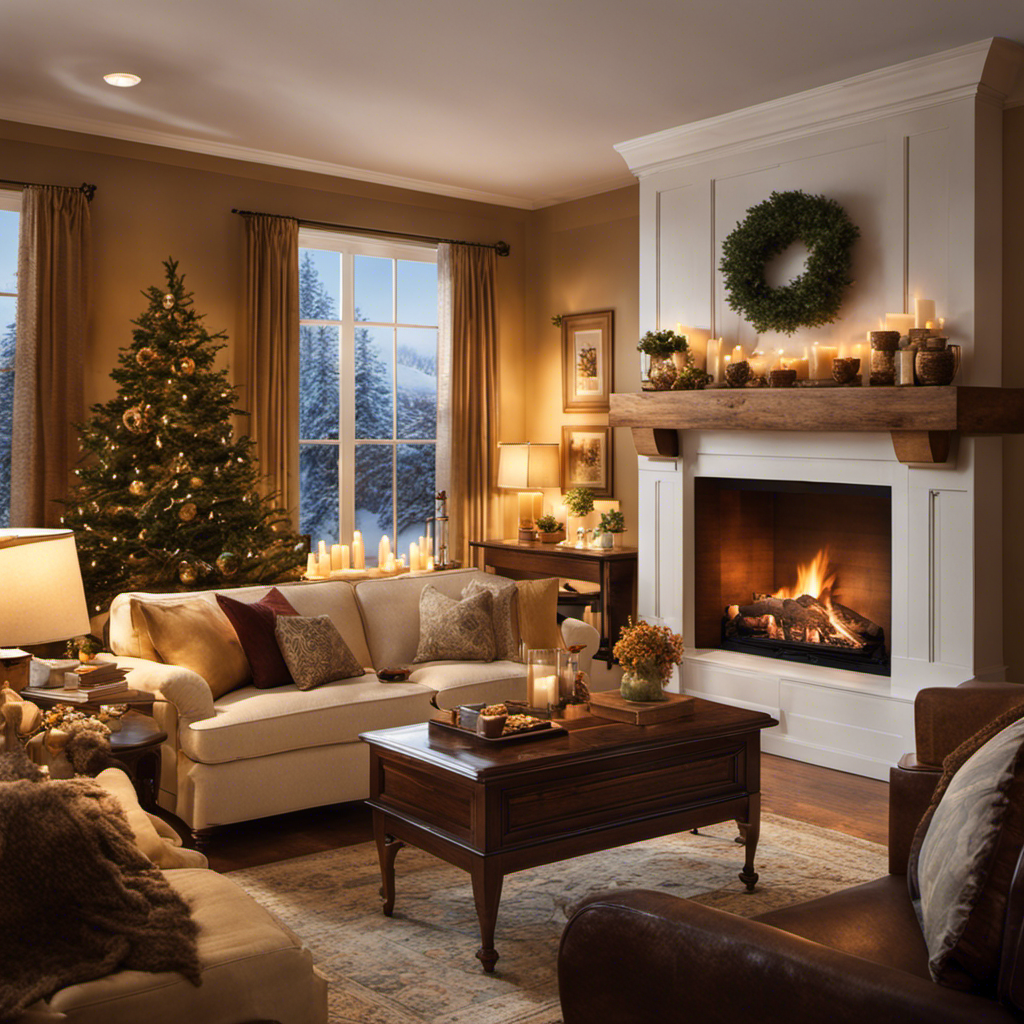In the event of a furnace failure, maintaining a warm and comfortable home becomes a top priority. This article aims to provide practical solutions to help you keep your house warm during such a situation.
By implementing effective insulation, utilizing alternative heating sources, maximizing natural sunlight, sealing drafts and leaks, optimizing thermostat settings, and strategically arranging furniture, you can ensure a cozy environment for yourself and your loved ones.
Stay prepared and take proactive steps to serve your household’s needs even when faced with unexpected challenges.
Key Takeaways
- Insulation and weatherstripping can help minimize heat loss and reduce heating costs.
- Exploring alternative heating sources such as electric space heaters, solar power, and geothermal heating can provide reliable and environmentally friendly options.
- Maximizing natural sunlight and heat through strategic window and skylight placement, as well as the use of thermal curtains or blinds, can create a warm and cozy atmosphere.
- Sealing drafts and leaks, through measures like weatherstripping and window caulking, is crucial for improving energy efficiency.
Insulate Your Home Effectively
Implementing proper insulation techniques is crucial for effectively maintaining warmth in your home when your furnace is no longer functioning. To ensure your home remains cozy and energy efficient, consider investing in energy efficient insulation options.
These options include materials such as fiberglass, cellulose, or spray foam insulation, which can help to minimize heat loss and reduce your heating costs.
Additionally, weatherstripping techniques can be employed to seal any gaps or cracks around windows and doors, preventing cold air from seeping in and warm air from escaping. Weatherstripping materials like adhesive-backed foam tape or door sweeps are simple yet effective solutions to keep your home insulated.
Utilize Alternative Heating Sources
Electric space heaters can serve as a reliable alternative heating source to keep your house warm when your furnace is no longer functional.
However, there are other alternative heating sources that can be considered as well.
One option is solar power. Installing solar panels on your roof can harness the energy from the sun and convert it into electricity to power heating systems in your home. Not only will this help keep your house warm, but it is also an environmentally friendly solution.
Another option is geothermal heating. This uses the natural heat from the earth to warm your home. Geothermal systems can be installed underground and utilize the stable temperature of the earth to provide consistent heating throughout the year.
Exploring these alternative heating sources can ensure that your house remains warm and comfortable even without a functioning furnace.
Maximize Natural Sunlight and Heat
To effectively maximize natural sunlight and heat in your home, it is important to strategically position and utilize windows, skylights, and other openings. Passive solar heating is a valuable method that harnesses the power of the sun to keep your house warm.
By strategically placing windows on the south side of your home, you can allow sunlight to enter and naturally warm up the space. Additionally, installing skylights or light tubes can bring in even more sunlight during the day.
To further enhance the warmth, consider using window treatments such as thermal curtains or blinds. These treatments can help retain heat by preventing drafts and insulating your windows.
Seal Any Drafts or Leaks
In order to effectively seal any drafts or leaks in your home, you need to identify the areas where air may be escaping and take appropriate measures to prevent it.
One of the most common areas for air leakage is around windows and doors. To address this issue, consider using weatherstripping to seal any gaps and cracks. Weatherstripping is a cost-effective solution that can help prevent drafts and improve the overall energy efficiency of your home.
Additionally, window caulking is another effective method to seal any gaps or cracks around your windows. By applying a fresh layer of caulk, you can prevent air leakage and keep your home warm during the colder months.
Optimize Your Thermostat Settings
Adjusting the temperature settings on your thermostat is a crucial step in maximizing energy efficiency and maintaining a comfortable indoor environment when your furnace is not functioning. By carefully adjusting the temperature, you can ensure that your home stays warm without wasting unnecessary energy.
First, set your thermostat to a lower temperature during the day when you are not at home. This will help save energy and reduce heating costs.
Second, when you are at home, program your thermostat to a comfortable temperature and avoid constantly adjusting it. Consistency is key in maintaining a warm and cozy atmosphere.
Implement Strategic Furniture Arrangement
Regularly rearranging your furniture and strategically placing it near windows and away from drafty areas can help maximize heat retention in your home when your furnace is not functioning. Furniture placement plays a crucial role in keeping your house warm during such times.
Start by moving your sofas and chairs closer to the windows, as sunlight can naturally heat up your living space. This will allow the warmth to circulate throughout the room, providing a cozy atmosphere.
Additionally, consider using thermal curtains on your windows. These curtains are designed to insulate your home by preventing heat loss through the windows.
Frequently Asked Questions
How Long Does It Typically Take for a Furnace to Be Repaired or Replaced?
The time frame for furnace repair can vary depending on the extent of the issue and availability of parts. It is recommended to contact a professional HVAC technician for an accurate estimate. In terms of cost, furnace replacement can be a significant investment, but it ensures long-term heating efficiency and comfort.
Are There Any Government or Local Programs That Provide Financial Assistance for Furnace Repairs or Replacements?
Government and local programs exist to provide financial assistance for furnace repairs or replacements. These programs aim to support individuals in need by offering resources to ensure warm and comfortable living conditions.
What Are Some Signs That Indicate a Furnace May Be on the Verge of Breaking Down?
Signs of a failing furnace include strange noises, uneven heating, and increased energy bills. When a furnace breaks down, take immediate steps such as checking the thermostat, inspecting the circuit breaker, and contacting a professional HVAC technician for repairs or replacement.
Can I Use a Space Heater as a Temporary Heating Source While Waiting for My Furnace to Be Fixed?
Using a space heater as a temporary heating source while waiting for furnace repairs can be an option. However, it is crucial to prioritize safety and follow guidelines for proper usage. Exploring alternative heating options may also be beneficial.
Are There Any Safety Precautions I Should Take When Using Alternative Heating Sources in My Home?
When using alternative heating sources, it is important to prioritize safety. Some safety tips include keeping heaters away from flammable materials and using carbon monoxide detectors. Common mistakes to avoid include leaving heaters unattended and using faulty equipment.


